The Memorial Gate was constructed after the models of Sadang Shrine and Geuknak Shrine built at the end of the Goryeo Dynasty(918~1392) and the beginning of the Joseon Dynasty (1392~1910), respectively, and the statues of sitting tiger at both sides symbolize the people's wish to protect the souls of the country's patriot martyrs and war dead.
- National Cemetery
- Memorial Facilities
- Brief Tombs
- Brief Activities
- Information
- Memorial Facilities
Memorial Facilities
-
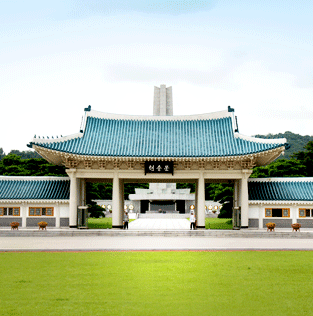
Memorial Gate
Memorial Gate (Hyeonchungmun)
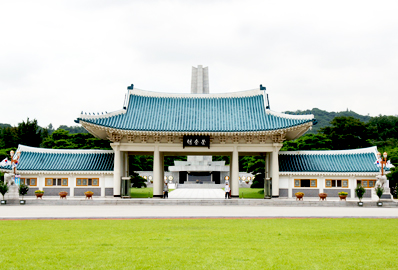
-
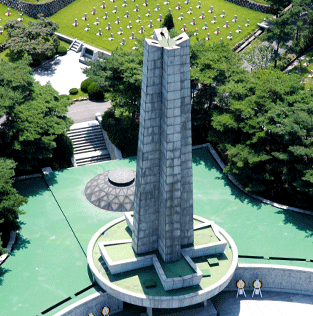
Memorial Tower
Memorial Tower
The Memorial Tower is the symbolic tower of the Seoul National Cemetery which heightens the loyalty and the spirit of sacrifice of the patriotic martyrs and the souls of all the fallen heroes who died protecting their motherland. It is a cross shape which means protecting four cardinal points North, South, East and West.
The granite stone walls lie at the both sides of the tower. A statue of five patriotic freedom fighters stands at the end of the left side stone walls and a statue of five National heroes stands at the end of the other side stone walls. The Memorial Tablet Enshrinement Hall is inside of the tower and a charnel house was built in the basement of the Memorial Tablet Enshrinement Hall. This tower was built on September 30, 1967 after one year construction and its height is 31 meters.The dedicated poem carved on the black stone of the Memorial Tower’s alter was written by Lee Eun-sang, and there is another dedicated poem written by President Park Chung-hee. And it says:
Here, the spirit of people indwelt
With homeland, they go eternally
May the Sun and the Moon protect this hill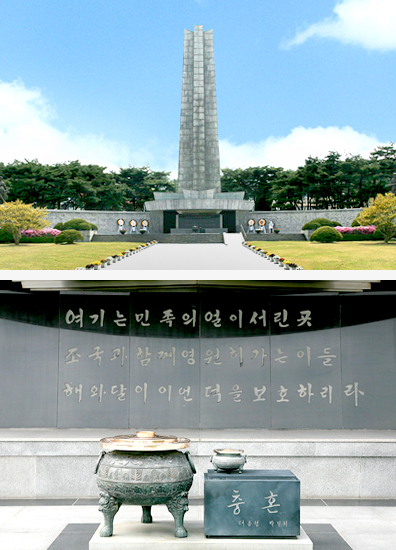
-

Altar to Patriots and Patriotic Martyrs
Altar to Patriots and Patriotic Martyrs
A lot of patriotic martyrs and patriots who sacrificed for independence of their country through the loyal troops activity in the late period of Chosun, the March 1 Movement, the armed struggle against Japan, the enlightenment movement and so on were enshrined. It is the memorial altar which was built by ‘the committee of building altars of heirless patriotic martyrs’ on November 17, 1971 for cherishing the memory of the spirits of patriotic martyrs who were enshrined here.
There is a bronze incense burner in front of the altar. At the top of the front of the altar, the writing written by President Park Chung-hee, The Sprit of Nation, is carved on the black stone. At the top of the back of the altar, there is the following dedicated poem written by Lee Eun-sang:
The nation and the people are my love,
my glory,
my strength, and
my life.
Giving my life for him,
living with him,
live forever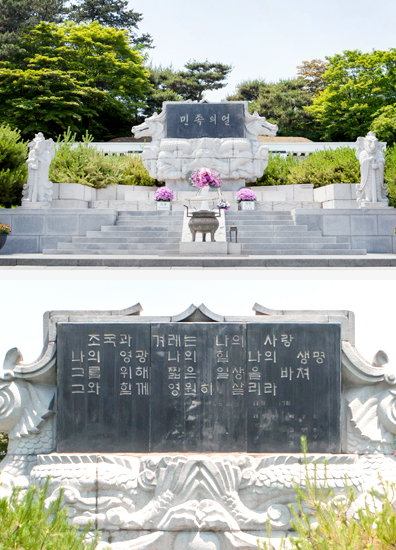
-
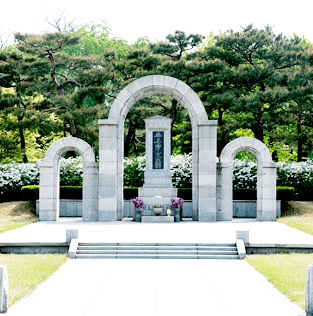
Memorial to the Unknown Student Volunteer Soldiers
Memorial to the Unknown Student Volunteer Soldiers
The homeland was in danger because of the Korean War; more than 50,000 students themselves in school uniforms joined in the front for saving their nation and fought bravely in Pohang and other areas.
About 7,000 of these unknown student volunteer soldiers died heroic deaths, but there was no way to find their bodies or even tombs. In the Memorial of the Unknown Student Volunteer Soldiers, the remains of 48 unknown student volunteer soldiers who dead in Pohang area in the Korean War were buried under a hemispherical stone grave. The 48 unknown student volunteer soldiers who buried here were temporary burial bodies near the Pohang Girls’ Middle and High school who were dead student volunteer soldiers who fought against outpost troops of North Korea in the Pohang battle. They were buried under control of Korean Student Volunteer Soldiers Society in the 5th national military graveyard at first on April 25, 1964 and moved the grave to the Memorial of the Unknown Student Volunteer Soldiers in April, 1968. To honor the student volunteer soldiers’ noble sprit of sacrifice, the Memorial of the Unknown Student Volunteer Soldiers was built in April, 1968.In front of the Memorial, it says, “To the souls of the unknown soldiers.”
At the back, it says, “The Korean unknown soldiers, the glory of people, rest in peace here.”
July 15, 1955(Dan-gun era 4288 / B.C. 4288), Korea
In front of the altar, it says, “The grave of the Student Volunteer Soldiers.”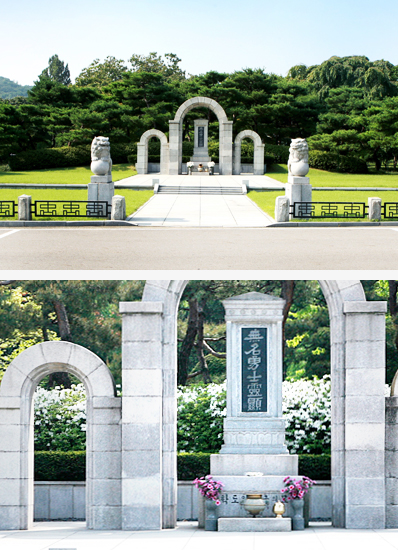
-

Memorial to the Unknown Soldiers of the Korean Independence Army
Memorial to the Unknown Soldiers of the Korean Independence Army
On May 17, 2002, the Memorial to the Unknown Soldiers of the Korean Independence Army was built to honor the unknown Korean Independence Army who joined in the independence movement in Manchuria and Maritime Province of Siberia so as to get back their nation during the Japanese colonial era.
Combination of three Taegeuk patterns of a semicircular shape was made on the pedestal of this Memorial to represent the sky and the everlasting light lantern was installed on it. The embossed carving walls of Blue Dragon at East and White Tiger at West which look like Cicada’s wings were built on the stereobate. The guardian statues were built at both sides on the stereobate.
Three columns named ‘Deliberation of Independence Army’ depicting independence fighters discussing their operations with their heads together were built at the center of the propitious site.
One of the columns is a 12m high-tower symbolizing the 12 month of one year, and the other two columns stand 16m and 14m high each to offer rhythmical variety in its visual image. This three-column structure of the Memorial represents the passage of time in a formative way.

-
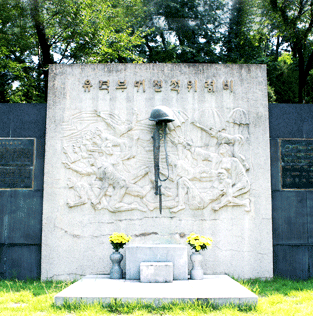
Korean War Guerrilla Fighters Memorial
Korean War Guerrilla Fighters Memorial
The Korean War Guerrilla Fighters Memorial was built on June 2, 1977 to honor the guerrilla fighters’ noble sprits of sacrifice and glorious achievements who died in the middle of launching a guerilla operation to protect freedom and peace in everywhere of North Korea during the Korean War and to cherish the memory of the souls.
On the Middle of the Memorial, the fight scene of the guerilla fighters was carved, and a helmet and a rifle which are the same things that the guerilla fighters used at that time are hanging on it.Also, a succinct history and an epitaph are inscribed on the left and right side of the Memorial; at the back of the Memorial, Korean anticommunist guerilla fighters’ unit designation list is inscribed.
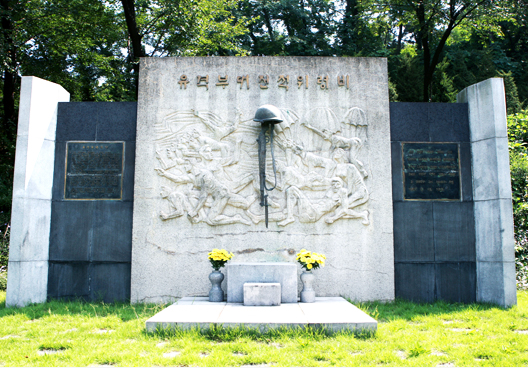
-
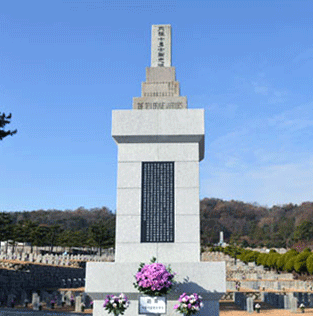
Ten Human Bombs Memorial
Ten Human Bombs Memorial
10 warriors were buried in the first raw at the 6th graveyard. On May 4, 1949, when the South Korea was in a confrontation with the North Korea by the 38th parallel, they dashed into the enemy’s position carrying primed bombs and broke the position. They died heroic deaths to recapture of the hill of Songak in Gaeseong that had been illegally taken by the North Korean army. They are 2nd Lieutenant Seo Bu-deok and Master sergeant Kim Jong-hea, Yoon Seung-won, Lee Hee-bok, Park Pyeong-seo, Hwang Geum-jae, Yang Yong-sun, Yoon Ok-chun, Oh Je-ryong and Park Chang-geun.
On May 4, 1955, which is the exact same date when these warriors were all fallen, the Ten Human Bombs Memorial was built to pray for the repose of these 10 warriors’ souls, cherish the memory of their great achievement and hand down the meaning to posterity for a long time.
To build this memorial, General Kim Suk-won, who was the divisional commander at that time when the 10 warriors died heroic deaths, was in the forefront and organized “Ten Human Bombs Memorial Building Committee” which philanthropist in Gaeseong and normal community leaders joined in.
This memorial shaped 5-story tower on the podium of the bottom. It is getting narrow when it goes up. An epitaph is inscribed on the very first bottom, and the English writing, ‘THE TEN BRAVE WARRIOR’, is written on the second bottom. On the top of that, the 10 warriors’ ranks and names are inscribed. The inscription, ‘The Ten Human Bombs Memorial’, is deeply cut on the very top.
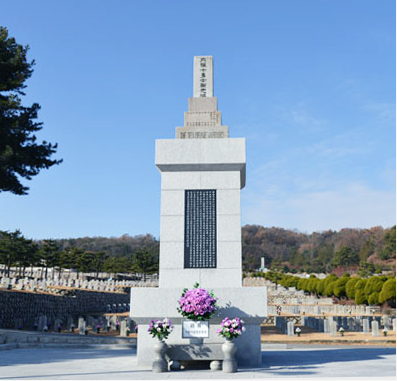
-

Memorial to Korean Student Volunteer Soldiers Resident in Japan
Memorial to Korean Student Volunteer Soldiers Resident in Japan
Upon the outbreak of the Korean War, Korean students residing in Japan organized a volunteer army, crossed the Korea Strait and entered the war. They distinguished great merits in the war. In the Graveyard of Korean Student Volunteer Soldiers Resident in Japan (the 16th Graveyard), 22 souls of the departed war heroes were buried and 83 whose bodies were never found are enshrined with tablets. On June 6, 1973, the Federation of Korean Residents in Japan built the Memorial to Korean Student Volunteer Soldiers Resident in Japan in front of the Graveyard to cherish their noble sacrifice and pay respects to their souls. After then, on December 15, 1990, it was rebuilt. A dedicated poem is inscribed in front of the memorial and the name list of 50 souls of the departed war heroes buried here is inscribed on the back of the memorial.
To save my country,
Young people spilled blood.
On a page of a book of history,
Embroidered with flowers
In the soft earth of motherland,
Rest in peace with smiling.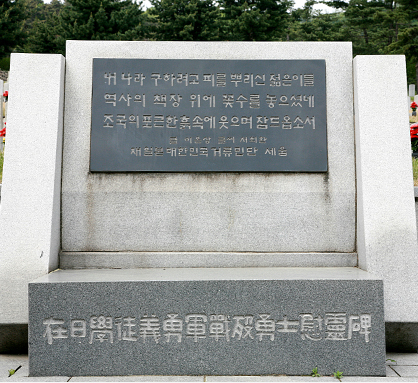
-
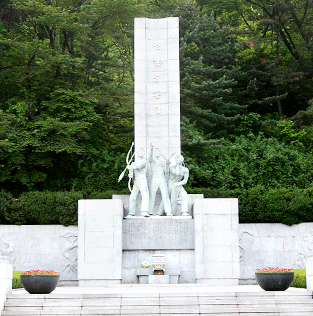
Memorial to Patriot Police Officers
Memorial to Patriot Police Officers
The police officers who sacrificed their lives to protect the nation during the Korean War were buried in the Graveyard: the police officers who maintained the public welfare and order: the police officers who protected citizens’ lives and properties. The Memorial to Patriot Police Officers has the walls which look like wings spreading like arms to both sides from the center of it, which means warm protection of democratic police officers. At the bottom of the memorial, the statue of three people which symbolizes the loyalty, the faith, and the courage of police activity is standing to represent the loyalty and service of the police officer. The statue of the love of people and the statue of a patriot stand at the left and right side of the memorial. The great achievements of police officers who protected the nation and people are carved on the walls.
The two statues of tiger which people believe as a guardian of legend stand at each side of the entrance to protect the souls. Enshrinement room which can set up some tablets is inside of the memorial. This memorial actually was built in the Bupyoung Police Training College at first. On May 30, 1967, however, it has been moved here and completed on May 22, 1979.
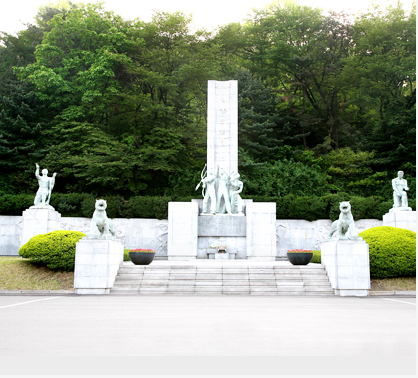
-
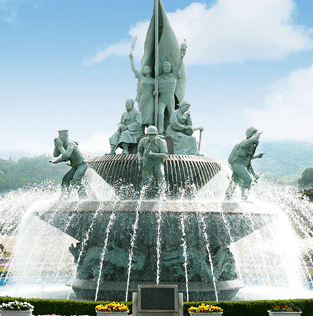
Chungseong Fountain Tower
Chungseong Fountain Tower
On November 5, 1976, this fountain tower was constructed to symbolize the great achievement and spirits of the martyred patriots and the souls of all the fallen heroes who died for the freedom, peace, and prosperity of the nation. The statues of male and female holding the laurel leaves on the top signify the free and peaceful nation, and the middle part symbolizes the people, who struggle and were devoted to their nation and to their people for the development and prosperity of the nation, while the lower part symbolizes the armed forces, polices, and reservists, who were devoted to the protection of the nation and the people.
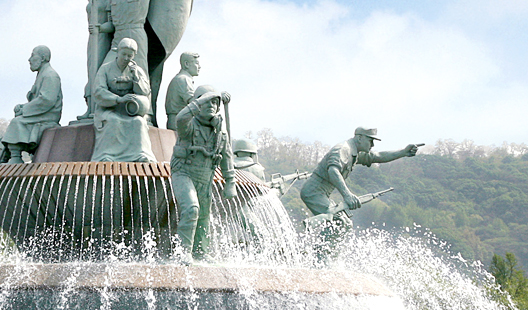
-
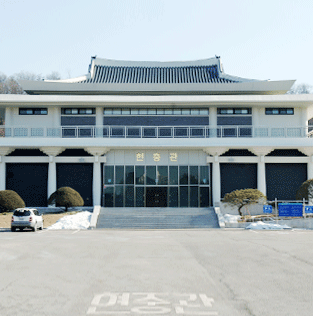
Memorial Hall (Theater)
Memorial Hall (Theater)
The Memorial Hall is carrying all kinds of ceremonies such as a burial ceremony and a send off ceremony of the dead. This building was built on December 31, 1980. It is a 2-story ferroconcrete roofing tile structure building and the total floor space is 15823 sqft. It is an eclectic structure building whose pillar, foundation stone and roof are traditional Korean style, and other parts are modern style. From November in 2011 to June in 2012, about 8 months, this building was remodeled. Now it has total 472 seats. (338 seats on the first floor, and 134 seats on the second floor)

-
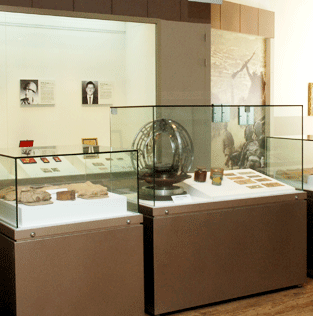
Photographic and Relics Exhibition House
Photographic and Relics Exhibition House
The Photographic Exhibition House exhibits the photos which show the history of the nation’s suffering and the action state of patriotic martyrs and patriots and products made in North Korea. This building was built on November 30, 1991. It is a 2-story ferroconcrete roofing tile structure building whose pillar, foundation stone and roof are traditional Korean style, and other parts are modern style. It improved as 3-dimensional exhibition, and reopened on April 4, 2003.
Relics Exhibition House exhibits relics and prize which patriots used when they were alive.
This building was built on August 31, 1990. It is a 2-story ferroconcrete roofing tile structure building whose pillar, foundation stone and roof are traditional Korean style, and other parts are modern style.
Exhumation Office was established in the Relics Exhibition House in December, 2010. This office found the relics through an exhumation business and exhibits the relics of the remains who died during the Korean War.
